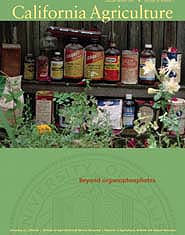All Issues

Beyond organophosphates
Cover:
Under the Food Quality Protection Act of 1996, many uses of organophosphate insecticides and other broad-spectrum pesticides are being phased out, with important implications for California growers; UC scientists are exploring a range of alternatives. Shown on this home gardener’s shelf are generations of pesticides, some of which have been banned or their uses curtailed.
Photo: Galen Rowell/Corbis
January-March 2005
Volume 59, Number 1
Volume 59, Number 1





